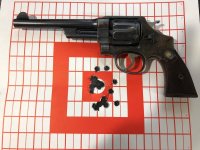
Every powder on the market burns cleaner at higher pressures.
I use 5.7gr of Titegroup under a cast 240gr LSWC in .44 Mag to give me a consistent 870fps from a 7.5-inch barreled Redhawk.
PRO: meters well, easy to find on the shelf to purchase, low cost, small charge weights make the cost savings even larger but my
favorite pro is that is tends to ignore cavernous empty space inside the case and it quite insensitive to powder position, so using it for light loads in big revolver cases works better than most other powders I have tried.
CONS: I'll list these line by line so they can be addressed
--there may exist no better powder to
blow up a firearm with a careless double or triple charge than Titegroup. High energy, low charge weights, dense, takes up such little space, it is perhaps the finest powder on the market if your goal was blowing up firearms. So while you must be diligent with all powders, this powder specifically won't tolerate carelessness.
--Titegroup is a high nitro powder and it absolutely burns
hot and in my experience, it burns hot enough that after many many trials with different bullets and charge weights, I have declared for the rest of my life that I'll never use Titegroup in .38 Special ever again... because I have grown up wrapping my left hand around the cylinder to eject brass and two cylinderfuls of Titegroup in a K-frame cylinder actually burns my left hand to the point where I don't want to handle the revolver. I have tried more times than I care to count and my final answer is simply that I don't use Titegroup in .38 Special. --HOT--
--it's either Titegroup or Power Pistol... but one or both of these will eat the plastic in my Lyman 55 hopper. Over years of use, it etches the inside of the plastic and eventually it destroys it, especially at the bottom of the hopper where it locks in to the metal unit. Obviously, much less so when you don't get in the habit of leaving the powder full for an overnight or longer... a habit to avoid generally with all powders. I believe the high nitro content of Titegroup may be the culprit? This isn't a big deal but it is relevant.
--for newer handloaders that haven't yet developed a "feel" for how to best make use of different powders, I personally believe that Titegroup (and some other powders) set a bit of a trap for the novice handloaders, a trap that is never warned by the powder manufacturers in their published load data... that trap being "Oh, here is load data for Titegroup, I have Titegroup, I'll just use Titegroup!" For a novice handloader, they see it published, they have the powder but they don't understand the reality behind what they are building. And .44 Magnum is a great example. In this particular discussion, we are talking Titegroup for very light, low/medium velocity loads, which is fine. But a novice will see full-pressure "magnum" loads and make them and figure he's got top-performing .44 Magnum when in fact he does not. What he has are loads that are top pressure, poor velocity because it is the wrong powder choice and a pressure curve that it the polar opposite of smooth and predictable. All the fury associated with a proper load but without the performance. And while the proper powder load can be developed, the Titegroup load will just lurch beyond "safe" without the warning you'll get from a proper, slow burning powder.
^So that's my biggest "con" and complaint with Titegroup. All the published data for Titegroup that is available, attempting to use it to run real magnum loads is a horrendous idea. For target velocities and reduced velocity loads in magnum chamberings, Titegroup is fantastic. For maximum loads, Titegroup is one of the worst powders on the market -- especially for novice handloaders that aren't familiar with burning rates.

